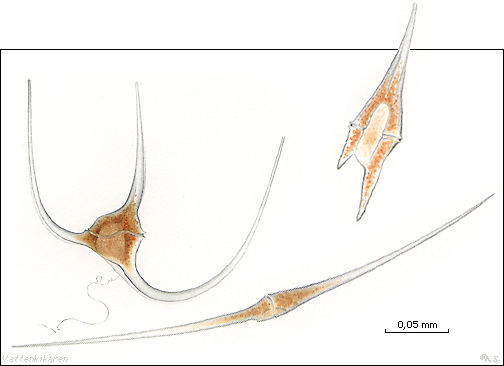 |
 |

 Distribution of scandinavian waters |
Maximum length: 0,54 mm. Compare
with the size of a hair. Appearance: Living ceratium-dinoflagellates are yellow or brown in colour. They consist of one somewhat flat cell that is not symmetrical. Sometimes the cells are attached to each other in pairs. The surface of the cell is broken by grooves that contain two mobile outgrowths (flagellae). The cross-wise groove along the middle of the cell clearly cuts the cell into an upper and lower half. In those cases where the groove goes up towards the upper cell half, it does so only a little bit. The outer casing around the cell is composed of plates that give rise to a rugged and strong armour. Depth: Ceratium-dinoflagellates are most common in the upper depths that are exposed to sunlight. Environment: Pelagic. Misc: Ceratium-dinoflagellates are found in both fresh and salt water over the whole world, even if they are most common in temperate areas. With the help of its flagellae these organisms can swim. They can also catch their food directly from the water and produce nutrients with photosynthesis. The large protrusions can also be used for protection against predators. Even within the same species, the cell form and the size of the protrusions can vary, both during the time of the year and in different areas. Ceratium-dinoflagellates can, mainly during the autumn, be so many that the water is coloured red. They can also emit light that is visible in the dark and appear as seasparkle. Classification: Ceratium-dinoflagellates are members of the dinoflagellate group under the "protists". The protists group is not a well defined group, as it is often used for organisms that are not bacterias, fungi, plants or animals. The flagellates pictured above belong to specie Ceratium longipes, Ceratium furca and Ceratium fusus. |